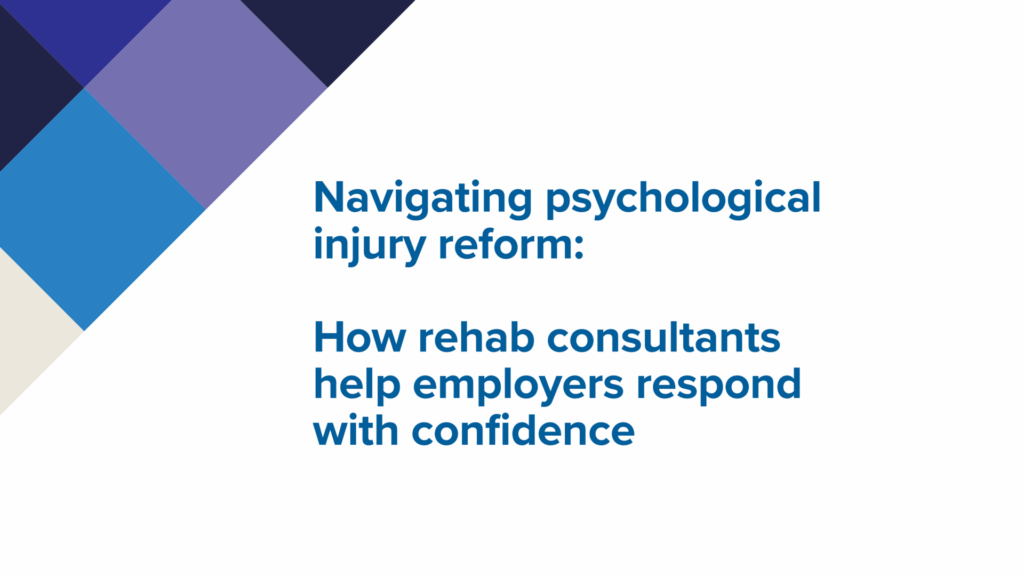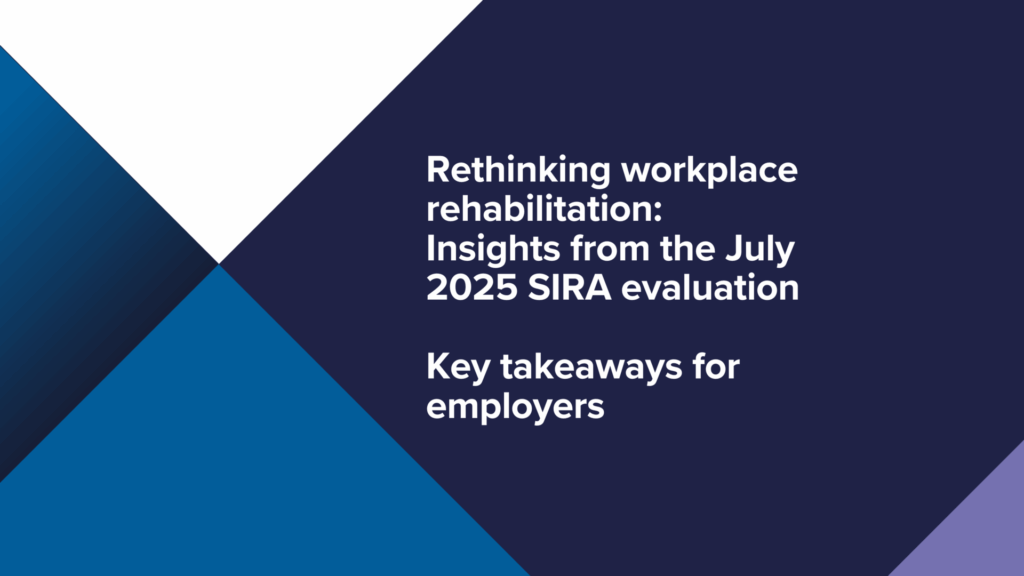Workplace injuries can have a significant impact on a business, from the loss of productivity and increased workers’ compensation premiums to disruptions that dampen morale and hurt your bottom line.
For today’s employers—who must balance protecting their workforce and achieving operational goals—tackling injury prevention and recovery effectively is a must.
Natalie Mumford, an experienced Rehabilitation Consultant and Occupational Therapist, helps businesses create safer workplaces while ensuring injured employees can return to work smoothly and sustainably.
What makes her approach unique is her ability to balance insight-driven solutions with her passion for fostering strong employer partnerships in the workers’ comp space.
Natalie believes that the best results come not just from processes but from relationships, where trust, understanding, and collaboration are key.
Whether you’re looking to strengthen your injury prevention policies or improve your strategy for managing injured employees, Natalie shares the critical questions employers should ask themselves—and the proven steps you can take—to make meaningful improvements in your workplace.
Ask yourself these four questions to identify gaps in your workplace safety strategy
Employers don’t always have the time to evaluate their injury prevention and recovery strategies proactively.
But asking these important questions could reveal untapped opportunities to improve:
1. Are we proactively addressing workplace risks?
Preventing injuries requires more than reacting to issues as they arise.
Natalie encourages employers to take a proactive approach by integrating risk assessments into every facet of their operations, from pre-employment screenings to ongoing evaluations of workplace hazards.
One crucial strategy Natalie advises is the use of pre-employment assessments—particularly for roles with manual handling or physically demanding tasks.
These assessments are designed to evaluate whether prospective employees are physically suited to the demands of the role.
By aligning the right people with the right jobs, employers can significantly reduce the likelihood of injuries down the line.
“I’ve worked closely with an employer who operates in highly manual roles, where injuries from lifting and repetitive strain were common,” Natalie explains.
“Through our relationship—established during their claims management process—we identified the need to implement pre-employment assessments. Today, their hiring decisions reflect not only the job requirements but also the long-term health and safety of their workers, and they’ve had a noticeable reduction in workplace injuries.”
In addition to pre-employment screenings, Natalie advocates for regular site inspections, ergonomic adjustments, and equipping employees with the skills to identify and address hazards themselves.
“Small, consistent steps in targeting risk areas—like improved workstation setups, better tool designs, or smarter hiring practices—can drastically reduce musculoskeletal injuries, which are among the most common workplace problems,” Natalie explains.
2. Do we have clear policies for reporting injuries and addressing them early?
One missed or late-reported injury can spiral into more serious consequences for both the employee and the business.
Having a simple and well-communicated process for reporting injuries is non-negotiable.
Even simple measures, such as ensuring supervisors are approachable and reinforcing that there is no penalty for reporting symptoms, can increase early intervention.
“Many employees don’t report pain until it’s too late because they think it will reflect poorly on their performance. Employers need to remove that stigma ASAP by showing that early reporting is essential to preventing further complications,” says Natalie.
3. Are our managers equipped to handle injury-related conversations?
Frontline supervisors play a huge role in injury prevention and management, but many lack the training they need to support employees effectively.
Natalie advises leadership teams to train managers on these key points:
- Recognising early warning signs of discomfort or potential injury.
- Guiding employees through the injury reporting process.
- Providing support for workers during their recovery, especially when return to work accommodations are needed.
“The relationship between a manager and an employee can make or break the success of recovery,” Natalie emphasises.
“Investing in training for managers shows your employees that they’re cared for.”
4. Are we tracking trends in workplace injuries?
Data is one of your most powerful tools in injury prevention.
Employers should review their workplace injury records, looking for patterns that can help identify risk areas.
Whether it’s repetitive injuries in certain roles or seasonal spikes, trends can guide resource allocation, training initiatives, and even staffing forecasts.
Proven employer strategies for better injury prevention and recovery
Once employers evaluate their current systems, Natalie offers several actionable strategies to improve both prevention and management of workplace injuries:
1. Build a positive return-to-work culture
Many employers focus on policies or paperwork when managing return to work, but Natalie highlights the importance of fostering a supportive culture.
Making injured employees feel valued and connected during recovery can reduce absenteeism and increase the likelihood of a successful return.
Pro tip: Create individualised return to work plans that reflect the employee’s abilities and focus on gradual reintegration.
2. Prioritise ergonomics to prevent common injuries
Natalie recommends simple but impactful ergonomic adjustments for many businesses.
For example, setting up adjustable desks for office employees or ensuring proper lifting techniques are taught to manual labourers can reduce the likelihood of strain and repetitive injuries.
“Ergonomics are a low-hanging fruit in injury prevention. They show employees that their comfort and safety isn’t something you leave to chance,” she notes.
3. Train and empower your team to take ownership of safety
Safety shouldn’t be seen as a top-down initiative.
Empower employees to take ownership of their safety by involving them in decision-making, such as reviewing risks in their workspaces or suggesting practical modifications.
Additionally, provide regular safety training tailored to specific roles.
For example:
- Lifting techniques and posture correction for warehouse staff.
- Fatigue management for drivers or machine operators.
- Workplace ergonomics for office-based employees.
4. Collaborate on return to work plans
Returning to work after an injury can often feel overwhelming—both for employees and employers.
Natalie stresses the importance of collaboration between injured workers, their supervisors, healthcare providers, and rehabilitation consultants.
This ensures a safe and sustainable transition back to work.
Why partnering with a consultant changes the game
For Natalie, injury prevention and management aren’t just about checking boxes—they’re about relationships.
Employers who partner with experienced consultants gain access to both strategic insight and hands-on support.
The benefits include:
- Cost reduction: Proactively addressing workplace risks and managing injuries efficiently can reduce workers’ compensation claims and shorten recovery times.
- Improved productivity: Supporting employees’ recovery ensures they return to work fully engaged and ready to contribute.
- Stronger employee retention: Employees stay loyal when they feel valued and supported, even during tough times like recovery from an injury.
“When employers take a relationship-driven approach to workplace safety, they’ll see an immediate benefit—not just in reduced risks or claims, but in employee engagement and trust. It’s a win-win,” Natalie explains.
Supporting employers every step of the way
Natalie Mumford and her team provide end-to-end solutions to help employers prevent injuries, manage risks, and support employees in returning to work.
By tailoring strategies to specific workplace challenges, they make it easier for businesses to protect their employees and improve productivity.
- Pre-employment assessments: Ensure candidates are physically suited to job requirements, reducing the risk of injuries in manual handling and physically demanding roles.
- Manual handling training: Equip employees with safe lifting techniques and posture skills to prevent injuries before they happen.
- Workplace assessments: Investigate injury causes and implement practical solutions like equipment upgrades, task redesigns, or workflow changes to mitigate future risks.
- Tailored return to work plans: Create individualised plans that ease injured employees’ transition back into meaningful work while supporting business needs.
- Ergonomic solutions: Improve workspaces and processes with cost-effective adjustments that prioritise employee safety and comfort.
These services are designed to not only reduce costs and claims but also foster stronger relationships and trust between employers and their teams.
Next steps for employers: how to take action today
If you’re an employer looking to improve your approach to injury prevention and management, take these steps today:
- Review your injury data and trends to identify risk areas or gaps.
- Assess your current policies for early reporting, injury management, and return to work.
- Engage managers and supervisors in training to better support injured employees.
- Reach out to an expert like Natalie Mumford for tailored guidance and support.
“With the right strategies, proactive policies, and collaborative relationships, employers can create workplaces that are safer, healthier, and more productive.
Let’s start building that together,” says Natalie.
For employers, successfully navigating injury prevention and management is a balancing act.
But with the right insights and support, businesses can reduce risks, recover faster, and foster a culture where employees feel truly cared for.
By asking the right questions, implementing proven strategies, and aligning with trusted experts, you can transform these challenges into opportunities to thrive.

Natalie Mumford
Rehabilitation Consultant & Occupational Therapist




